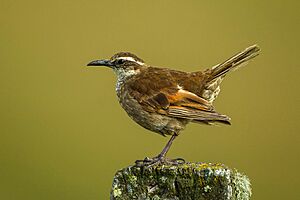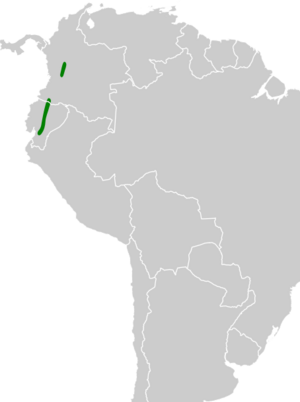Stout-billed cinclodes facts for kids
Quick facts for kids Stout-billed cinclodes |
|
|---|---|
 |
|
| Conservation status | |
| Scientific classification | |
| Genus: |
Cinclodes
|
| Species: |
excelsior
|
 |
|
The stout-billed cinclodes (Cinclodes excelsior) is a type of bird. It belongs to the ovenbird family called Furnariidae. You can find this bird in Colombia and Ecuador.
Contents
About the Stout-billed Cinclodes
What's in a Name?
Scientists have sometimes placed the stout-billed cinclodes in different bird groups, like Upucerthia or Geositta. However, most major bird classification systems do not use these groupings.
Some experts also thought the stout-billed cinclodes might be the same species as the royal cinclodes (C. aricomae). But the evidence for this idea is not very strong.
Subspecies of the Stout-billed Cinclodes
The stout-billed cinclodes has two main types, called subspecies:
Appearance of the Stout-billed Cinclodes
The stout-billed cinclodes is a fairly large bird, about 20 to 21 cm (8 to 8.3 inches) long. It weighs around 62 to 66 grams (2.2 to 2.3 ounces). It has a thick beak that curves downwards. Both male and female birds look alike.
Feather Colors and Markings
Adults of the excelsior subspecies have a long white stripe above their eye, called a supercilium. This stripe goes all the way to the back of their neck. Their cheeks are whitish with dark marks. The rest of their face is dark brown with some light streaks.
Their head and upper body are dark brown. Their wings are also dark brown, with some reddish-brown color near the base of the flight feathers. Their tail is dark brown, becoming more reddish-brown towards the outer feathers.
The throat is whitish, and the upper chest is light brown with faint lighter marks. The lower chest and belly are brownish with light streaks. Their sides are brown with pale streaks.
Other Features
The bird's eyes are brown. Its beak is black, and its legs and feet are brownish-gray to blackish. Young birds look similar to adults but have more mottled (spotted) chests.
The columbianus subspecies has slightly darker upper parts and lighter underparts. It also has a clearer reddish-brown band on its wings compared to the excelsior subspecies.
Where the Stout-billed Cinclodes Lives
The stout-billed cinclodes lives in different areas that are not connected. This is called a disjunct distribution.
Location of Subspecies
- The C. e. columbianus subspecies lives further north, in the Tolima Department of Colombia's Central Andes mountains.
- The C. e. excelsior subspecies lives in the Andes mountains. You can find it from the Nariño Department in southwestern Colombia, south through Ecuador, all the way to Azuay Province.
Preferred Homes
These birds live in various places. They like rocky páramo grasslands and moist mountain scrublands. Sometimes, they live in groves of Polylepis trees or barren areas with scattered shrubs. They especially like areas near water and wet, boggy meadows.
You can usually find them at high elevations, between 3,200 and 4,500 meters (10,500 and 14,800 feet) above sea level. They can even go as high as 5,200 meters (17,100 feet) near the snowline.
Behavior of the Stout-billed Cinclodes
Movement and Migration
The stout-billed cinclodes stays in its home area all year long. It does not migrate.
What They Eat
These birds mainly eat small creatures without backbones, like insects. They also eat seeds and sometimes small animals like frogs. They look for food alone or in pairs. They probe and dig in moist soil, mud, and plant debris to find their prey. Sometimes, they pick food from low plants.
Reproduction and Life Cycle
The stout-billed cinclodes breeds during the austral summer, which includes November and December. Scientists believe these birds are monogamous, meaning they have one partner.
Males sing and perform a wing-flapping display from a perch. The birds build their nests at the end of a tunnel. They dig these tunnels in earth banks, especially in soft, crumbly soil. Inside the tunnel, they make a soft bed of plant material. They are thought to lay two eggs. We don't know how long the eggs take to hatch or how long it takes for the young birds to leave the nest.
Bird Calls and Songs
The song of the stout-billed cinclodes is a rising, swelling trill, which sounds like "tr-r-r-r-r-r-r-reet". Their calls include a nasal "kiu" or "druut" or "ken-eek". They also make low twittering sounds when flying.
Conservation Status
The IUCN (International Union for Conservation of Nature) has listed the stout-billed cinclodes as a species of Least Concern. This means it is not currently in danger of extinction.
While its range is somewhat limited and its exact population size is unknown, experts believe the population is stable. No immediate threats have been found. The bird is considered uncommon to locally common. It lives in at least two protected areas in Ecuador.


